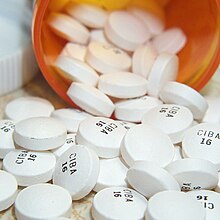Center for Drug Evaluation and Research
| Regulation of therapeutic goods in the United States |
|---|
 |
|
Prescription drugs Over-the-counter drugs |

The Center for Drug Evaluation and Research (CDER, pronounced "see'-der") is a division of the
CDER receives considerable public scrutiny, and thus implements processes that tend toward objectivity and tend to isolate decisions from being attributed to specific individuals. The decisions on approval will often make or break a small company's stock price[
The center has around 1,300 employees in "review teams" that evaluate and approve new drugs. Additionally, the CDER employs a "safety team" with 72 employees to determine whether new drugs are unsafe or present risks not disclosed in the product's labeling.[citation needed]
The FDA's budget for approving, labeling, and monitoring drugs is roughly $290 million per year[citation needed]. The safety team monitors the effects of more than 3,000 prescription drugs on 200 million people with a budget of about $15 million a year[citation needed].
Patrizia Cavazzoni is the current director of CDER.[1]
Responsibilities
CDER reviews
The FDA requires a four-phased series of
With the rapid advancement of biologically-derived treatments, the FDA has stated that it is working to modernize the process of approval for new drugs. In 2017, Commissioner Scott Gottlieb estimated that they have more than 600 active applications for gene and cell-based therapies.[2]
Divisions
CDER is divided into 8 sections with different responsibilities:[3][4]
- Office of New Drugs
- This office is responsible for oversight of clinical trials and other studies during drug development, and for the evaluation of new drug applications
- The Office of New Drugs is divided into several departments based on the indication of the drug (the medical need for which it is being proposed)
- Office of Generic Drugs
- This office reviews generic drug applications to ensure generic drugs are equivalent to their branded forms
- Office of Strategic Programs
- This office is responsible for business programs, represents CDER in the FDA Bioinformatics Board, and communicates with other agencies
- Office of Pharmaceutical Quality
- This office is responsible for integrating assessment, inspection, surveillance, policy, and research activities to strengthen pharmaceutical quality on a global scale.
- Office of Surveillance and Epidemiology
- This office is responsible for post-marketing surveillance to identify adverse effects that may not have been apparent during clinical trials, using the MedWatch program
- Office of Translational Sciences
- This office promotes collaboration across offices in CDER by maintaining databases and biostatistical tools for evaluating drugs
- Office of Medical and Regulatory Policy
- This office develops and reviews guidelines pertinent to CDER's mission of ensuring the safety of drugs
- Office of Compliance
- This office ensures compliance with regulations relating to drug development and marketing
History
The FDA has had the responsibility of reviewing drugs since the passage of the 1906
In 1982, when the beginning of the
In 1987, under Commissioner
In its original form, CDER was composed of six offices: Management, Compliance, Drug Standards, Drug Evaluation I, Drug Evaluation II, Epidemiology and Biostatistics, and Research Resources. The Division of Antiviral Products was added in 1989 under Drug Evaluation II due to the large amount of drugs proposed for treating AIDS.[5] The Office of Generic Drugs was also formed.
In 2002, the FDA transferred a number of biologically produced therapeutics to CDER.
References
- ^ "CDER Leadership Bios". FDA. 22 December 2022. Retrieved 24 December 2022.
- ^ Burton, Thomas M. (7 September 2017). "FDA Modernizing Evaluations as Gene, Cell Therapy Fields Grow". Wall Street Journal – via www.wsj.com.
- ^ "Archived copy" (PDF). Food and Drug Administration. Archived from the original (PDF) on 2017-01-13. Retrieved 2017-02-01.
{{cite web}}: CS1 maint: archived copy as title (link) - ^ Research, Center for Drug Evaluation and (3 March 2022). "About the Center for Drug Evaluation and Research - CDER Offices and Divisions". www.fda.gov.
- ^ a b "A Brief History of the Center for Drug Evaluation and Research". US FDA. Retrieved 1 February 2017.
- ^ a b c d e f Reid, Ken. "CBER and CDER have long history of being lumped together and split up." Bioresearch Monitoring Alert Sept. 2002. page 4.
- ^ Research, Center for Drug Evaluation and (2 November 2021). "About the Center for Drug Evaluation and Research - Drug Application and Approval Process -". www.fda.gov.
